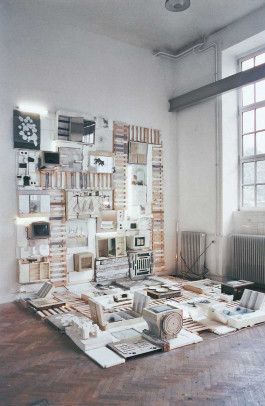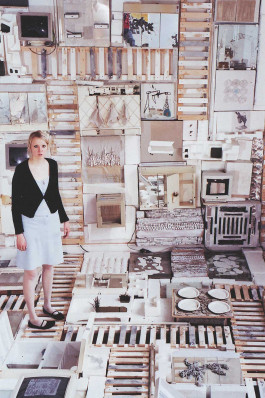Dummheit von 1000 Töpfe (Das Moor: Überwachungsstaat)
HFBK Hamburg

Verena Issel has a lively, almost libidinous relationship with the material world, with the unique characteristics of its materialities, surfaces, structures, forms and colors, self-organizations, and other qualities, and especially with how these are present in the utilitarian and other objects of northern and central European culture with which she is familiar.
It would be wrong, however, to associate her material world with that of Arte Povera, since it is far removed from any dualistic pathos, but rather, in the broadest sense, with the world of objects of Nouveau Réalisme, and then (also in terms of the abundance of her activities) much closer to Dieter Roth than to Jason Rhoades, for example. She prosaically sets in motion an unpuristically complex, playful arte povera ricca that robs the abundance of the representational world, which is inevitably material in many ways, of all pre-coding and thus of its triviality, in order ultimately to gain knowledge from this liberation through enchantment.
In her choice of materials and objects, as well as in her choice of dimensions, combinations, origin, appearance, age, and even genre, there are hardly any clear preferences; she draws with great ease from unlimited resources. And she can justifiably rely on her almost somnambulistic aesthetic certainty of purpose, which is nourished by the independence of her mind, her love of experimentation, and her wide-ranging interests.
As a result, her work to date is already characterized by a remarkably multi-layered corpus, which can be seen in a general and genre-separating way, including drawing, photography, albums and notebooks (printing techniques of all kinds, batik), painting, flat and spatial multi-material and multi-media collages, wall and floor reliefs, murals, objets trouvés, sculpture (wood, plastic, ceramic, metal, plaster, papier-mâché), mosaic, installation, staged natural and artificial light, sound, kinetics, performance, and video.
However, a basic principle of her three-dimensional works, as well as her notebooks, books, and albums, which are always also reliefs, is that the above-mentioned genres do not appear separately as individual pieces, but rather manifest themselves simultaneously in a variety of ways, overlapping one another, emerging from one another, breaking apart, or dimensionally intensifying in the respective structure. In this way, highly complex material, medial, and dimensional systems are created, which are realized in small to very large dimensions and are of surprisingly peculiar and yet different beauty on all individual levels and as a whole.
These ordered conglomerates also stand in different and varying relationships to space; they not only stand, hang, or lie, but can also form themselves as lying objects from lying and/or standing objects, or as lying objects merging into hanging objects or vice versa, and so on.
In addition, the large units are composed of many different smaller and autonomous subunits, which in turn can be composed of even smaller subunits, and thus represent the basic material structure of all matter.
This applies in particular to the two large polymorphic installations: Dummheit von 1000 Töpfe (Das Moor: Überwachungsstaat) and a large, untitled double-walled piece, which, despite its many differences from the installation, will not be described further here.
She is not concerned a priori with the principle of the Gesamtkunstwerk, but rather with illustrating her interest in systems and structures, their connections and overlaps, their interleavings and breaks both in languages and in the spaces of living, architecture, cities, etc.—that is, in systems of civilization as forms of human organization and communication. And she makes a point of entering these spaces in her own particular way, which she describes as “empathy versus abstraction.”
[…]
It would probably be going too far to go into other levels of Verena Issel’s work here, although its differentiated complexity would certainly demand it.
I have therefore tried to limit myself to the most important aspects.
☐ Andrea Tippel, expert recommendation for a scholarship
INGREDIENTS
- Überwachungswohnung I
- Überwachungswohnung II
- Überwachungswohnung III
- Überwachungswohnung IV
- Überwachungswohnung V
- Organik vs. Anorganik I
- Organik vs. Anorganik II
- Organik vs. Anorganik III
- Organik vs. Anorganik IV
- Organik vs. Anorganik V
- Schrankbett
- Dürers Mutter in der Schublade
- Teekran
- Superrechner
- Superrechner II
- Polizei
- Fabrik
- Moorgarten II
- Mikroskophasi I
- Mikroskophasi II
- Teigschrank
- Teigschrank II


Dummheit von 1000 Töpfe (Das Moor: Überwachungsstaat)
2004, various materials, dimensions variable
Photo: Isabel Mahns- Techau
Dummheit von 1000 Töpfe (Das Moor: Überwachungsstaat)
2004, various materials, dimensions variable
(and a dazed mini Issel, ambushed by the photographer at 8am after pulling an all- nighter in order to finish the show)
Photo: Isabel Mahns- Techau